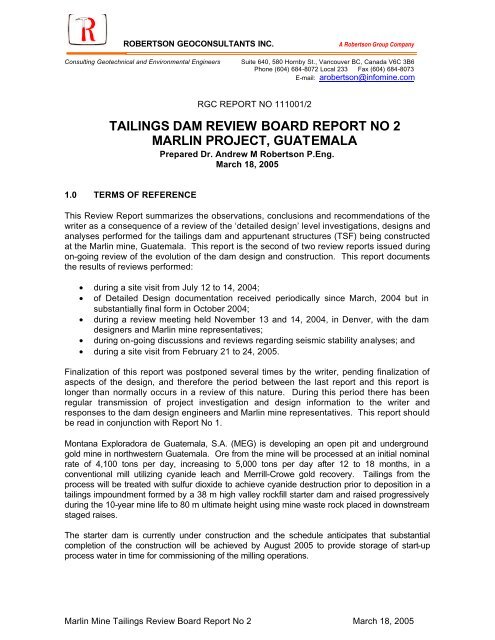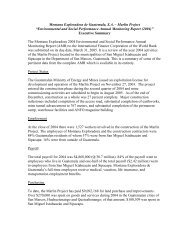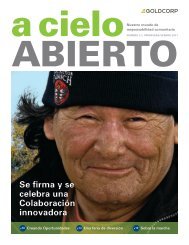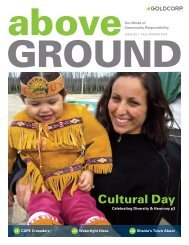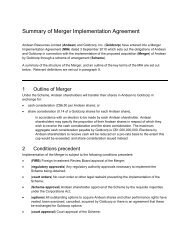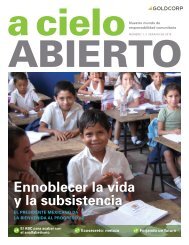Marlin Tailings dam Review Board Report No 2 - Goldcorp
Marlin Tailings dam Review Board Report No 2 - Goldcorp
Marlin Tailings dam Review Board Report No 2 - Goldcorp
Create successful ePaper yourself
Turn your PDF publications into a flip-book with our unique Google optimized e-Paper software.
Robertson GeoConsultants Inc. Page 5and wetting-up of the dry weak waste rock in the pile will reduce the stability for boththe current pile and its future development. This would place a risk on both men andvehicles working on the pile, or in the valley below the pile where foundationpreparation for the main waste rock dump will occur. It is recommended that astability evaluation be performed as a matter of priority, with the objective of beingable to perform any mitigation measures that may be concluded from the study priorto the onset of the next wet season.3.0 REVIEW ACTIVITIES3.1 Site Visit July 12 to 14, 2004Prior to making the site visit a ‘Draft <strong>Tailings</strong> Disposal Facility Design <strong>Report</strong>’ prepared byMEC was received and reviewed.11 th July 2004 – traveled from Vancouver to Guatemala City12 th July 2004 – traveled to the project site from Guatemala City to site by helicopter. In thecompany Mr. Dorey of MEC, made a site inspection as follows:• Visited and viewed foundation excavations for core trench on right abutment (PhotoB-4) and inspected exposed rock.• Inspected equipment and viewed procedures for drilling and grouting of grout curtainon right abutment (Photos B-1, 2, and 3)• Inspected diversion intake and pipe and foundation zone for coffer <strong>dam</strong> (Photo B-5)• Inspect potential core material exposed in excavations in potential borrow areas• Visited and viewed on site soils laboratory• Visited and viewed the waste rock pile at the exploration adit entrance (Photos B-6and 7) and inspected some available core from the underground exploration.• Met MEC site QA/QC staff and discussed grouting procedures and grouting resultsobtained.Returned to Guatemala City.13 th and 14 th July 2004 - reviewed draft tailings <strong>dam</strong> design documentation in the offices ofMEG in Guatemala City and discussed reviewed materials with Mr. Dorey of MEC and Mr.Miller of MEG. Comments on the designs were provided. The author requested andreceived permission for Dr. Peter Byrne, specialist in dynamic stability of <strong>dam</strong>s to beconsulted with regard to the dynamic stability analyses of the <strong>dam</strong> that had been performed.15 th July 2004 – traveled from Guatemala City to VancouverOn returning to Vancouver Dr. Peter Byrne was consulted and provided with the relevantsections of the draft Design <strong>Report</strong> relating to dynamic stability analyses. Dr Byrne maderecommendations for additional analyses and alternative analyses methods.3.2 Meeting of <strong>No</strong>vember 13 and 14, 2004Prior to the meeting of <strong>No</strong>vember 13 and 14, 2004, the author received a preliminary copy of the<strong>Marlin</strong> Project: <strong>Tailings</strong> Disposal Facility Design <strong>Report</strong>. Volume I, Main <strong>Report</strong> dated October 14,2004. This Design <strong>Report</strong> was reviewed and the design discussed with Mr. Dorey and staff ofMEC and Mr. Miller and Mr. King of MEG at a meeting in Denver on <strong>No</strong>vember 13 and 14, 2004.Comments on the design elements were provided at the meeting. These comments have beenaddressed by MEC and MEG in the final design documents.<strong>Marlin</strong> Mine <strong>Tailings</strong> <strong>Review</strong> <strong>Board</strong> <strong>Report</strong> <strong>No</strong> 2 March 18, 2005
Robertson GeoConsultants Inc. Page 6Dynamic stability analyses methods and alternative analyses were on-going during this periodwith a number of analyses submittals and reviews by Dr Byrne.3.3 Site Visit February 21 to 24, 2005A revised and final design report ‘<strong>Marlin</strong> Project: <strong>Tailings</strong> Disposal Facility Design <strong>Report</strong>.Volume I dated January 2005, Volumes II to V dated October 2004 and Volume VIattachment 2, dated <strong>No</strong>vember 2004 were received and reviewed prior to the site visit ofFebruary 21 to 24. The final report from Dr Byrne, which records his observations andrecommendations, was also received and this report is attached as Appendix A.20 th February 2005 – traveled from Vancouver to Guatemala City21 st February 2005 – traveled to the project site from Guatemala City to site by helicopter. Inthe company Mr. Dorey of MEC, made a site inspections on the 21 st and 22 nd as follows:• Inspected the excavations and foundations for core trench to the main <strong>dam</strong> (Photo C-1), including the right abutment foundation rock prior to dental concreting (Photos C-2and C-3), the left abutment foundation rock and trenching for the low level outlet pipe(Photos C-4 and 5).• Inspected on-going grouting equipment and procedures (Photos C-6 and 7).• Inspected the foundation stripping and foundation for the main drain, the main drainmaterials and construction methods (C-8, 9 and 10).• Visited the quarry being developed as a source for the crushing plant preparingmaterial for the filter and drain as well as the aggregate plant installed to process thematerials, and the products (Photos C-11 and 12). The quarry on the left flank of theimpoundment being developed for the shell rock for the starter <strong>dam</strong> was alsoinspected.• Inspected the excavation to bedrock for the monitoring weir (Photo C-13), and thefoundation excavations for the pumpback system.• Visited and viewed the stripping, foundation preparation and initial materialsplacement for the saddle <strong>dam</strong> on the right flank off the impoundment (Photo C-14).• Inspected the waste rock pile formed at the adit entrance for underground exploration(Photo C-15), including the drainage from the backslope and valley and from the aditthat is directed in culverts across the pile and discharges onto the face of the pile.•On the 22 and 23 rd , met with:• MEC staff responsible for QA/QC and reviewed the grouting and check holepermeability test records and results, and• MEG mine planner, Mr. Baptista, who is responsible for the geological block modeland open pit planning and obtained plots of pit wall exposures of highly, marginal andnon-acid generating rock types, as well as a tentative waste production schedule.On the 23 rd , prepared the key findings of this review and presented and discussed these withMr. Dorey and MEC staff, and returned by plane to Guatemala City.24 th February, met with and discussed key findings with Mr. Miller of MEG and travelled fromGuatemala City to Vancouver.<strong>Marlin</strong> Mine <strong>Tailings</strong> <strong>Review</strong> <strong>Board</strong> <strong>Report</strong> <strong>No</strong> 2 March 18, 2005
Robertson GeoConsultants Inc. Page 9Since the issuing of <strong>Report</strong> <strong>No</strong> 1 by this <strong>Board</strong>, geohydrological conditions have beeninvestigated with additional drillholes in the right flank of the impoundment. We are satisfiedthat extent and quality of this investigation is sufficient to characterize the ash depositsforming the right flank ridge, and that permeabilities have been demonstrated to beadequately low to control seepage to the east. Seepage to the west is controlled by thegroundwater height which is higher than the future elevation of tailings in the TSF.4.4 TSF Site conditionsThe geology, rock and soil properties of the <strong>dam</strong> site have been adequately characterized,as has been demonstrated now by the findings during excavation and foundationpreparation.4.5 <strong>Tailings</strong> Basin HydrogeologyWith the completion of the 2004 drillhole investigation program, and the grouting and testingprogram for the grout curtain, the hydrogeological conditions have been adequatelyinvestigated and characterized for design and seepage assessment purposes.The permeability of bedrock is highest in the upper weathered zone. The potential forseepage in this zone is controlled by the grout curtain under the core of the Main Dam andthe location of the low permeability east Saddle Dam (Photo C-14). Any seepage bypassingthe grout curtain is expected to emerge in the stream channel immediately downstream fromthe grout curtain and be collected in a seepage collection pond. This pond is located onbedrock. In addition a monitoring weir close to the ultimate seepage collection pond islocated on competent bedrock (see Photo C-13).4.6 Foundation Construction and <strong>Tailings</strong> CharacteristicsThe geology, geotechnical and rock conditions of the site have been adequatelycharacterized for foundation design and construction purposes, as has been demonstratedby experience during the earthworks and foundation preparation that has been completed.We have reviewed the investigation methods, laboratory testing and material propertiessummaries that have been prepared and are in agreement with these.The borrow material for the low permeability core is found in shallow (2 to 5 m depth)deposits about the basin of the impoundment. These deposits are of limited extent requiringcareful control of excavation in the borrow pits. Material placed in the east Saddle bermappears well suited to its purpose. MEC is alerted to the need for diligent control ofexcavation of this borrow at the source.The identification of adequate and economic sources of other construction materials hasproven to be somewhat of a challenge. Initial difficulties in securing a suitable source of filtermaterial resulted in the requirement for this to be initially imported from a commercial source.A quarry has now been located in the Rio Quivichil valley downstream from the <strong>dam</strong> site.This was being developed during the period of the site inspection and R3 or better rock wasbeing processed at an aggregate plant brought in for this purpose. Inspection of the plantindicated it to be in good condition and effective in producing the required products. It wasobserved that the filter material particles were rather ‘platy’ and highly susceptible tosegregation (see Photo’s C-11 and C-12). The filter material meets grading specificationsand is considered suitable. To prevent the segregation observed in Photo C-11 it will be<strong>Marlin</strong> Mine <strong>Tailings</strong> <strong>Review</strong> <strong>Board</strong> <strong>Report</strong> <strong>No</strong> 2 March 18, 2005
Robertson GeoConsultants Inc. Page 10necessary to control segregation by adopting special placing methods and blending andmixing procedures in the field. MEC is alerted to this requirement.The quarry for the shell rock was being developed during the site visit. Material had beenremoved only in the weathered bedrock that could be ripped. Observed exposures were oflow strength rock (R1 and R2) and had very high fines contents. The suitability of rock atgreater depth, likely requiring blasting, remained to be established. This rock may bemarginal for Phase 1 <strong>dam</strong> construction. For Phases 2 and 3 the shell rock will be obtainedfrom the open pit mining operations where drill core has established the presence of higherstrength rocks (R3) that are expected to be suitable for <strong>dam</strong> construction.Two additional samples of tailings material have been produced, representative of from thefirst and second half of mine life. Physical and geochemical testing of these tailings havebeen completed.While the physical testing has a number of anomalous results, and the sample set is small,we are in agreement with the parameters selected by MEC for representative permeabilityand consolidated density, for use in TSF design. There is uncertainty as to what the‘correct’ values will be, once full-scale production and actual field conditions of segregationand layering are established in the tailings pond. However the design of the impoundment,for the first two years of operation, is not highly sensitive to these properties, and it isrecommended that they be checked during the first year of production. Should they prove tobe substantially different from the values assumed the designs for later Phases of the <strong>dam</strong>can be amended appropriately.Additional geochemical testing of the new tailings samples and supernatant provide a muchimproved indication of tailings effluent quality. These chemical analyses must beconsidered as ‘indicator’ tests only since actual field concentrations could be found to varysubstantially from such small pilot scale samples. Natural degradation of some constituentswill occur in the pond on a scale not reflected in laboratory testing. Solutions are gypsumsaturated with low concentrations of a number of metals and ammonia at elevatedconcentrations.The static testing for acid generating potential of the tailings indicate that they will not be acidgenerating. While kinetic testing has been performed and test results do not indicatesignificant propensity for neutral leaching.We have reviewed the testing results and conclude that for this stage of evaluation theconcentrations assumed for contaminant concentration estimation in the tailings pond anddischarge waters are appropriate.4.7 TSF DesignThis section provides a detailed description of the TSF layout, elements of the design and itsoperation. It describes the sequence of construction, material sources and performancecapabilities (such as flood storage capacity). We have reviewed these and are of the opinionthat the facility has been thoroughly thought through. The design represents a practical,workable, economic system for tailings solids storage and mine and mill process watermanagement. The Design <strong>Report</strong> provides a clear and rational description of all the majorelements of this design, the way they are intended to function and design basis. All designassumptions and values are provided.<strong>Marlin</strong> Mine <strong>Tailings</strong> <strong>Review</strong> <strong>Board</strong> <strong>Report</strong> <strong>No</strong> 2 March 18, 2005
Robertson GeoConsultants Inc. Page 11Numerous design measures and details have been discussed between the reviewer, MECand MEG personnel at the July, <strong>No</strong>vember and February meetings. All questions, issuesraised, and recommendations provided have been addressed satisfactorily, excepting onlythose which apply to later Phases of design and can be addressed later, or require additionalinformation, such as shell rockfill properties from the quarry being developed, or productiontailings effluent water quality.We are in agreement with the basis for, and design of:• Main Embankment• Saddle Berm• Embankment Internal Drains• Grout Curtain• Seepage Collection pond• East Ridge Abutment Wells• TSF Decant System• Return Water System• <strong>Tailings</strong> Delivery System• Operation and monitoring to the extent explained (Operating Manual not yet availablefor review)• TSF Embankment Monitoring• TSF Closure to the extent explained (Closure Plan not yet available for review)4.8 TSF Design AnalysisThis section describes the various analyses performed to evaluate performance or designelements of the TSF. Considerable review effort was applied to the evaluation of theseanalyses. Questions raised during the July and <strong>No</strong>vember 2004, and February 2005meetings have all been satisfactorily responded to.4.8.1 Hydrologic Containment and Seepage through TSF EmbankmentWe have reviewed the basis and conclusions of the seepage modeling performed for boththe basin-wide seepage modeling (MODFLOW modeling) and the seepage through the TSFembankment modeling (SEEP-W modeling). We are in agreement with the approach,parameters used, calibration (where applicable) and results.The seepage estimates indicate low seepage values which, combined with the tailingseffluent water quality anticipated, are not expected to result in environmental impacts to thedownstream environment.4.8.2 StabilityConsiderable review was made of both the static and dynamic stability of the Main Dam.Since the stability is most critical during large seismic induced accelerations, these analysescontrol <strong>dam</strong> slope angles.We are in agreement with the investigation and test work performed to determine the <strong>dam</strong>construction material strengths and deformation parameters as well as the seismic inducedground motion at the <strong>dam</strong> site.<strong>Marlin</strong> Mine <strong>Tailings</strong> <strong>Review</strong> <strong>Board</strong> <strong>Report</strong> <strong>No</strong> 2 March 18, 2005
Robertson GeoConsultants Inc. Page 12Dr. Peter Byrne, specialist in dynamic stability analyses of <strong>dam</strong>s, was the prime reviewer ofthe dynamic stability. Between July 2004 and February 2005 there were a number ofreviews of interim analyses resulting in recommendations for alternative or additionalanalyses. MEC has responded to these questions and suggestions appropriately and a finalconclusion has been reached as summarized in the Executive Summary section of thereview report prepared by Dr. Peter Byrne.“The expected movements for the design earthquake are quite large, but providedappropriate design features are incorporated in the <strong>dam</strong>, the risk of <strong>dam</strong> failure and therelease of tailings, is minimal in the event of the design earthquake.These features involve:1. Provision of freeboard to accommodate at least 1 m of crest settlement;2. Wide filters and transition zones to resist horizontal movements and possible tensioncracks in the core. The filters should be at least 3 m and preferably 5 m wide andcomprise of concrete sand with essentially no fines. The movements andaccelerations are expected to be largest in the crest area, and particular attentionshould be paid to filter criteria in the top 20 m of the <strong>dam</strong>.”MEC has indicated that the filters and transition zones will be increased in width in Phases 2and 3 of the <strong>dam</strong>, and this is considered appropriate.4.8.4 Water balanceA detailed water and load balance has been developed to determine water release quantitiesand assess qualities. As for the previous analyses, these have been extensively reviewed.We are in agreement with the methodology and the factors and parameters used for thevarious inputs to the model. There is uncertainty with regard to many of the parameters,ranging from mine dewatering flows and qualities to precipitation variations (wet and dryyears) and uncertainties regarding mill startup schedule. The water balance model has beenused to demonstrate the sensitivity to some of these variables and can be used to managethe water accumulation strategy for the impoundment.The model has demonstrated the ability to store the first two years of tailings and processaffected water, and the rate and duration of discharge in subsequent years is estimated.Load balance calculations, based on conservative behaviour of effluent constituents, havebeen used to explore potential contaminant concentrations in release waters in the absenceof water treatment. It is intended that the release of water from the impoundment will beregulated to match stream flow in the receiving environment (Quivichil and Rio Cuilco), suchthat concentrations in the receiving water is below levels of concern. It is understood thatMEG are currently in discussions with Guatemala regulatory authorities to establish suitabledownstream water quality objectives and discharge criteria. MEG have committed toachieving international standards of water quality in the downstream receiving streams.MEG strategy for release management is to determine pond water qualities during the firstyear to establish if water treatment will be required. If required it would be installed andoperational by the time discharge commences.<strong>Marlin</strong> Mine <strong>Tailings</strong> <strong>Review</strong> <strong>Board</strong> <strong>Report</strong> <strong>No</strong> 2 March 18, 2005
Robertson GeoConsultants Inc. Page 134.9 Construction ScheduleThe design schedule indicates an earthworks placement schedule starting January 3 rd andcompletion of work by June 30 th , 2005. However, due to the projected delay in the deliveryof materials on the critical path, at the time of February visit, the earthfill placement wasprojected to be delayed by about 6 weeks, and arrangements had been made for thecontractor to go to double shifting for earthworks placement. The placement schedule isambitious and the consequences of not achieving the completion schedule for waterimpoundment in the early wet season are substantial, in that lack of water in storage maylimit mill commissioning and operation. Under such an ambitious schedule additional anddiligent site supervision and quality control is essential to maintain the quality of <strong>dam</strong>construction. Particular care will be required for vulnerable elements such as the fairlynarrow and segregation prone filter zone. MEC is aware of this concern and has madearrangements for additional staff to provide the site supervision required.5.0 NEXT REVIEW MEETINGIt is appropriate that the next site visit be made when the earthworks are nearing completion.The last week of May 2005, appears to be appropriate.By that time it is anticipated that the reports for the design of the WRF and Attachments 1, 3and 4 to Volume VI of the Design <strong>Report</strong> may be available for review.The key findings from this review have been summarized in Section 2.0 of this report.We would welcome the opportunity of answering any questions you may have wit respect tothis report.Yours trulyDr. A. MacG. Robertson. P. Eng.President – Robertson GeoConsultants Inc.<strong>Marlin</strong> Mine <strong>Tailings</strong> <strong>Review</strong> <strong>Board</strong> <strong>Report</strong> <strong>No</strong> 2 March 18, 2005


